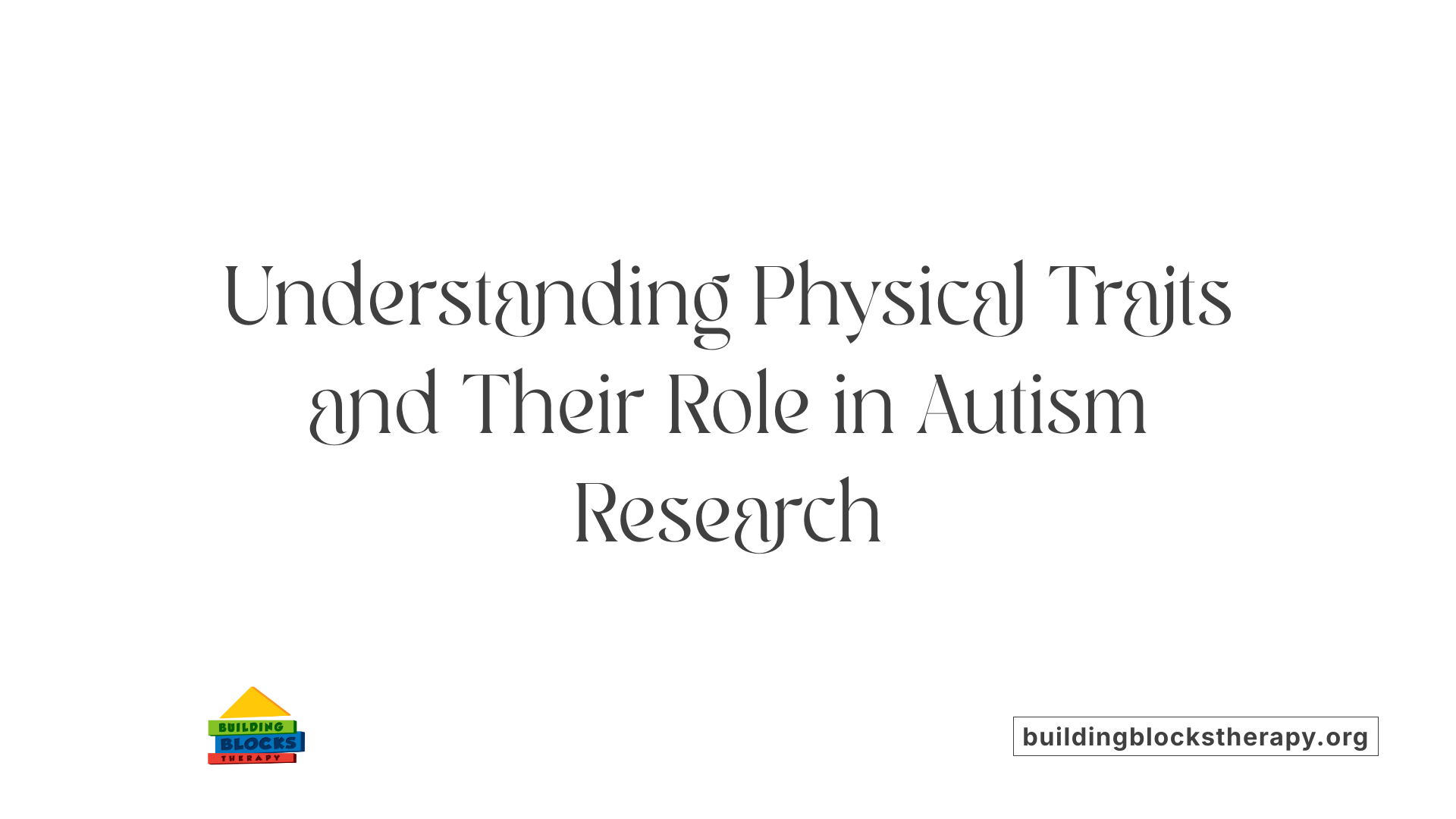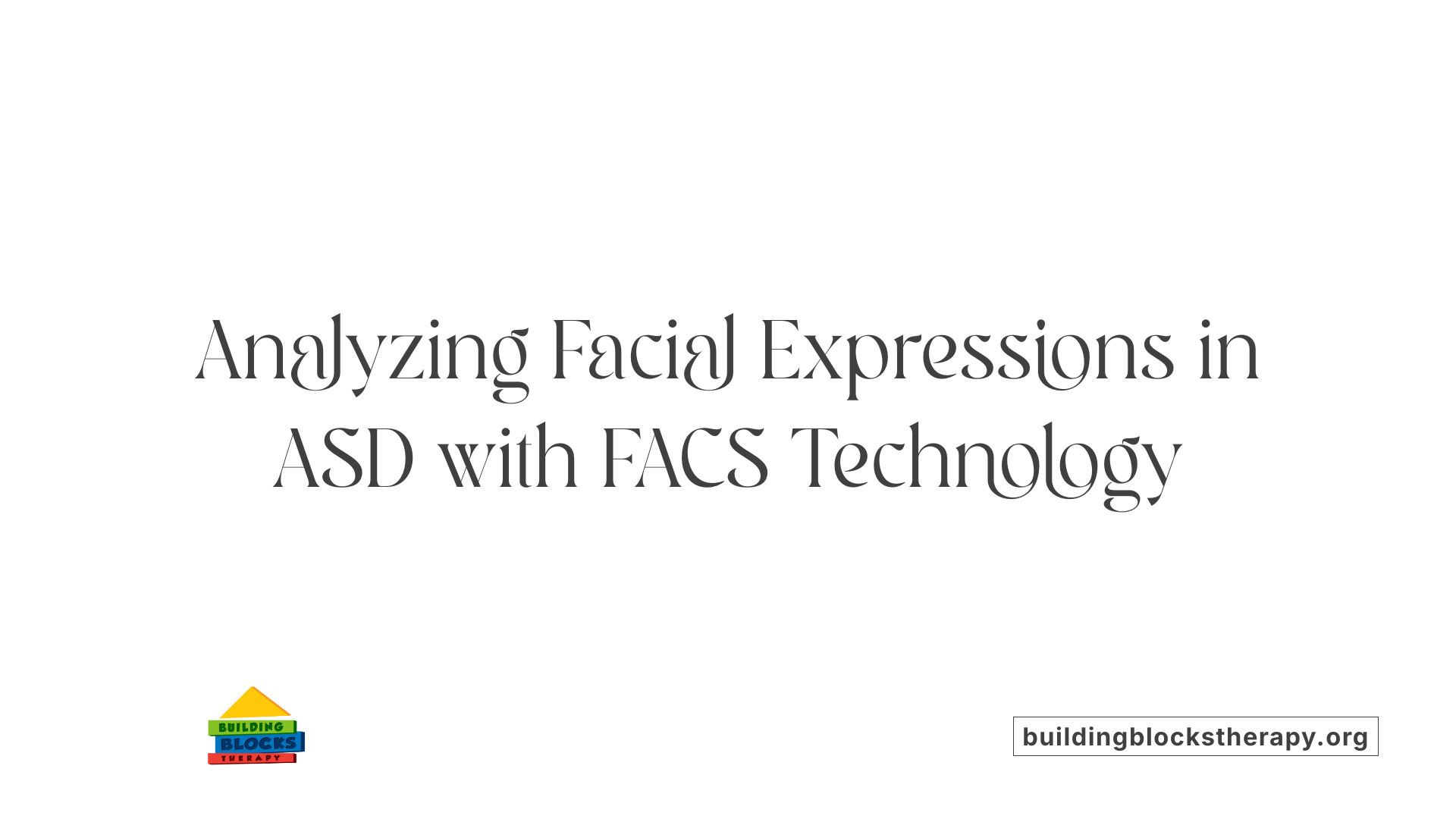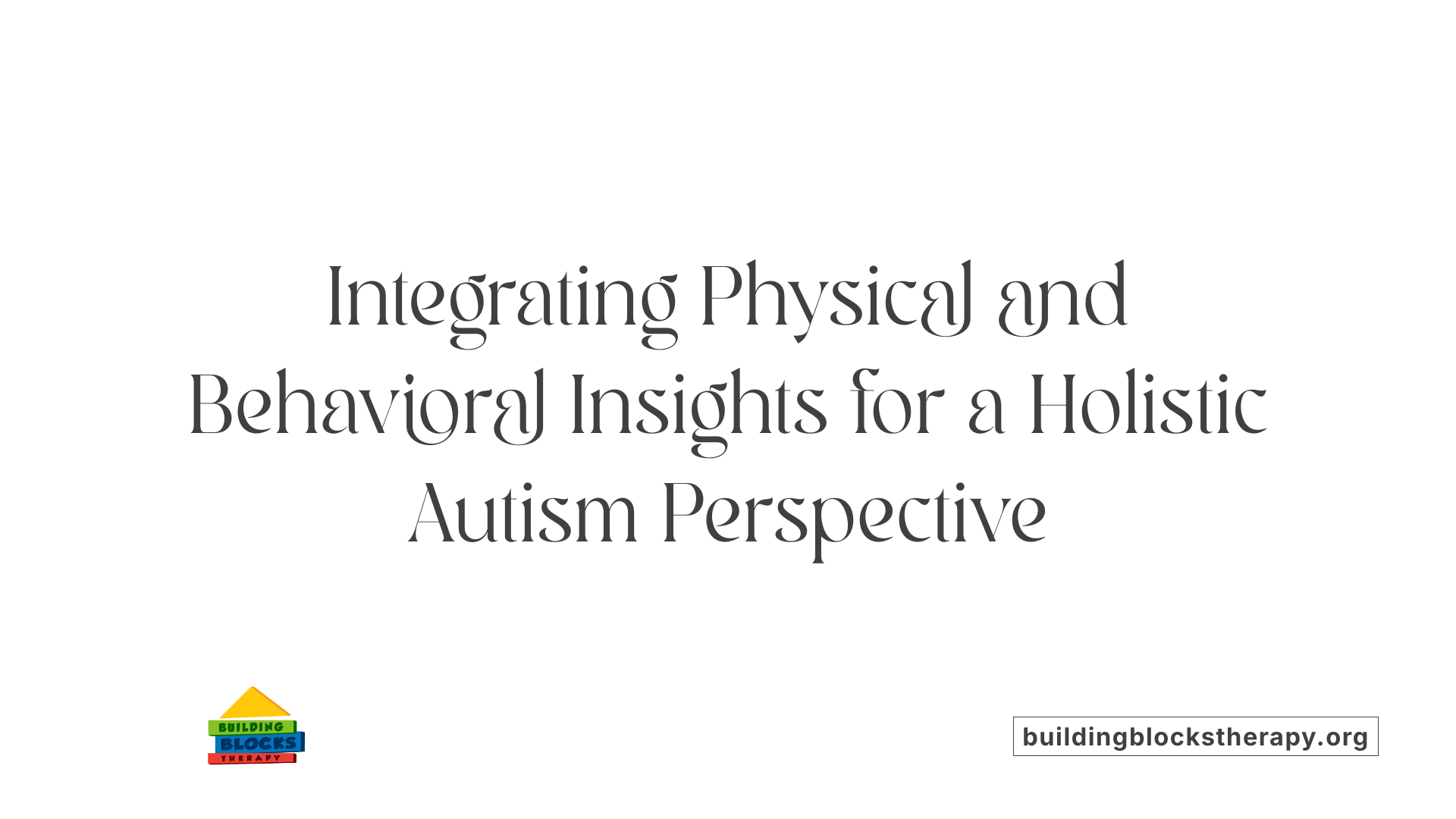Facial Features & Physical Characteristics Of Autism
Unraveling the Subtle Physical and Facial Traits Linked to Autism Spectrum Disorder

Exploring the Intersection of Facial Features and Autism Spectrum Disorder
Autism Spectrum Disorder (ASD) is widely recognized as a neurodevelopmental condition characterized primarily by social and behavioral differences. However, research has also explored whether distinct physical and facial characteristics accompany ASD, offering new perspectives on understanding this complex spectrum. While these features are not diagnostic on their own, they provide intriguing insights into the broader manifestations of autism, complementing behavioral assessments that remain central to diagnosis and intervention. This article delves into the current understanding of facial morphology, physical traits, and their implications within the autism spectrum, alongside a detailed discussion of behavioral therapies such as Applied Behavior Analysis (ABA).
Understanding Autism Spectrum Disorder Beyond Behavior

What is autism?
Autism is a neurodivergent difference in how the brain functions, impacting how a person interacts socially and behaves. Rather than being a disease or illness, autism reflects variations in neurological development that influence communication, social relationships, and patterns of behavior.
Does autism present uniformly across individuals?
Autism is best understood as a spectrum condition, which means it includes a diverse range of traits and experiences. Autistic individuals can have many strengths, such as honesty, deep focus, and special interests, alongside challenges like difficulties with social communication or repetitive behaviors. This diversity means no two autistic individuals are exactly the same.
Neurological basis and behavioral characteristics
The neurological differences seen in autism manifest in various social and behavioral ways. For example, children with autism may show limited eye contact, delays in language or gestures, and engage in repetitive movements. These behaviors stem from underlying brain differences influencing communication and sensory processing.
Autism's manifestations vary widely with age and individual profile. Some may have co-occurring conditions like anxiety or sensory sensitivities, further influencing their experience. By understanding autism as a complex neurodevelopmental difference with broad variation, we can better appreciate the unique strengths and needs within the autism community.
Physical Features Associated with Autism: Current Research Insights

Are there identifiable facial features linked to autism?
Research into autism spectrum disorder (ASD) has explored various physical characteristics, including facial morphology. Some studies suggest that certain facial features may be associated with ASD; however, these physical markers are not definitive or used as diagnostic criteria. Instead, they supplement behavioral assessments that remain central to the diagnosis.
Observations on non-definitive diagnostic physical markers
While physical traits like distinct facial morphology have been observed, no single physical characteristic confirms autism. These features can vary widely among individuals on the spectrum, reflecting the broad diversity within ASD.
How does facial expressivity differ in individuals with ASD?
Research examining facial expressivity indicates that individuals with high-functioning ASD show less differentiated facial responses when viewing emotional expressions such as cheerfulness, anger, sadness, and anxiety. This reduced expressivity, or “flat affect,” impacts nonverbal communication abilities and may hinder affect recognition by others.
Implications of reduced facial expressivity in ASD
The diminished range of facial responses can interfere with interpersonal resonance, making social interactions more challenging. Such subtle differences in nonverbal cues contribute to difficulties in social communication characteristic of ASD.
These findings emphasize the importance of behavioral and communicative analyses in autism assessment, as physical features alone do not adequately capture the complex nature of the disorder.
Facial Action Coding System (FACS) Studies: Emotional Expression in ASD

Use of FACS in analyzing facial muscle movements
The Facial Action Coding System (FACS) is a tool used to measure facial muscle movements by categorizing facial expressions into action units. In autism spectrum disorder (ASD) research, FACS helps examine how individuals express emotions like cheerfulness, anger, sadness, and anxiety through facial responses. This method provides an objective way to assess dynamic facial expressivity beyond subjective observations.
Comparison of facial responses in individuals with and without ASD
Research involving 21 individuals with high-functioning ASD (HF-ASD) and 21 neurotypical controls found that while the overall facial muscle movement range did not differ significantly between groups, those with HF-ASD showed less differentiated, or less varied, facial responses to emotional stimuli. Essentially, people with ASD activate facial muscles in a less nuanced way when observing emotions, which contrasts with the richer, more specific facial expressions shown by neurotypical individuals.
Impact on recognition of emotions and interpersonal communication
The less differentiated facial expressions among individuals with HF-ASD can impede their ability to recognize emotions in others. This reduced emotional resonance disrupts nonverbal communication and can make social interactions more challenging. Because facial expressivity is crucial in conveying and interpreting feelings, these differences may contribute to the social disadvantages commonly experienced by people with ASD, such as difficulties in empathy and bonding.
| Aspect | ASD Individuals (HF-ASD) | Neurotypical Controls | Social Impact |
|---|---|---|---|
| Facial muscle movement range | Similar overall range | Similar overall range | No difference in movement capacity |
| Differentiation of expressions | Less nuanced and less varied responses | More nuanced and specific facial responses | Impaired emotion recognition in ASD |
| Emotion recognition | Hindered by less differentiated expressions | Facilitated by rich facial expressions | Potential social disadvantages for ASD |
This research highlights how subtle differences in facial expressivity measured by FACS contribute to the social communication challenges in ASD, emphasizing the importance of tailored behavioral interventions.
Early Physical and Behavioral Signs of Autism in Childhood
What early facial or physical signs might indicate autism in young children?
Early signs of autism often appear during infancy and can be observed through specific facial and social behaviors. Children with ASD commonly avoid eye contact and may not respond to their names by around 9 months of age. They might also lack typical facial expressions such as happiness, sadness, anger, or surprise in this early period. By 12 months, delays in social gestures become evident; for instance, children might not wave goodbye or participate in simple interactive games.
Delayed social gestures and communication milestones
Social communication delays are characteristic, with limited use of gestures like pointing or sharing interests typically noticed between 15 to 18 months. These delays can impact early bonding and interaction, signaling the need for further developmental screening.
How do repetitive behaviors manifest physically in autistic children?
Repetitive behaviors are commonly exhibited by autistic children and can be physical and verbal. Examples include lining up objects meticulously, flapping hands, or repeating phrases (echolalia). In addition, autistic children often show unusual sensitivities to sensory input like sound, smell, taste, sight, or touch. These sensory sensitivities can further influence how repetitive behaviors present and how the child interacts with their environment.
Together, these early facial, social, and behavioral signs provide important clues for caregivers and healthcare providers to identify autism spectrum disorder during critical developmental windows. Prompt attention to these indicators facilitates early intervention and better support outcomes for the child.
Genetic and Environmental Contributions to Physical Traits in ASD
What factors contribute to the development of autism-related physical characteristics?
Autism spectrum disorder (ASD) arises from a complex interaction of genetic and environmental influences. Research indicates that there is no single genetic cause; instead, multiple gene variations contribute to the neurodevelopmental differences seen in individuals with ASD. These gene variations affect brain development and physical traits associated with autism.
Environmental factors, particularly prenatal conditions, also play a significant role. Factors such as maternal health, exposure to toxins, or complications during pregnancy may influence the development of autism-related traits.
The combined effect of genetics and environment extends to physical characteristics that sometimes correlate with autism. For example, certain facial morphology traits have been studied for potential links to ASD, though these features are not definitive diagnostic markers.
Understanding the multifactorial origins of ASD helps explain the wide range of physical and behavioral traits observed. Genetic contributions influence the formation and function of neural systems critical for social communication and behavior, while environmental factors may modulate these effects throughout development.
Behavioral Analysis and Diagnosis: Complementing Physical Observations
How is autism diagnosed if there are no medical tests?
Autism spectrum disorder (ASD) cannot be diagnosed through medical or genetic tests; instead, the diagnosis relies heavily on developmental screening and detailed behavioral observation. Specialized tools such as the Autism Diagnostic Observation Schedule (ADOS) play a central role. ADOS involves structured activities that allow clinicians to observe social interaction, communication, and play behaviors that may indicate autism traits.
What is the role of behavioral analysis in autism treatment?
Behavioral analysis is foundational both for diagnosing ASD and guiding personalized intervention plans. By carefully assessing behaviors and developmental milestones, professionals can identify individual strengths and challenges unique to each person on the spectrum. This approach enables the creation of tailored therapies that improve social communication skills, manage repetitive behaviors, and support emotional regulation.
Why is behavioral assessment necessary alongside physical observations?
While some studies explore physical features like facial morphology in relation to ASD, these physical traits are not definitive for diagnosis. Behavioral analysis provides a dynamic and contextual understanding of how individuals interact and respond to their environment. It captures vital nuances such as reduced facial expressivity or differing nonverbal communication patterns, which physical measures alone cannot adequately assess.
Diagnostic process and ongoing support
The diagnostic process typically involves multiple observations over time, factoring in developmental history and standardized screening tools. Early identification through behavioral signs such as limited eye contact, language delays, or repetitive movements can facilitate prompt intervention, which significantly enhances long-term outcomes. Furthermore, behavioral analysis continues to be valuable in tracking progress and adapting therapies as individuals grow and their needs evolve.
Applied Behavior Analysis (ABA) Therapy: Science-Based Intervention
What is Applied Behavior Analysis (ABA) therapy, and how is it used in treating autism?
Applied Behavior Analysis (ABA) therapy is a science-based approach that plays a crucial role in the assessment and intervention for autism spectrum disorder (ASD). It focuses on understanding how behavior works, how behavior is affected by the environment, and how learning takes place. ABA therapy applies this understanding to improve specific behaviors and develop important skills by using various techniques tailored to an individual's unique strengths and challenges.
Definition and Principles of ABA Therapy
ABA therapy is built on the principles of learning theory, emphasizing positive reinforcement to encourage desired behaviors. This means rewarding behaviors that are beneficial and functional, which gradually helps individuals with autism improve their communication, social interaction, and daily living skills.
Techniques Used in ABA Therapy
One common technique is discrete trial training (DTT), which breaks down skills into small, manageable steps, teaching each step intensively until mastered. Therapists use repetition and consistency to reinforce these behaviors. Other approaches may include natural environment teaching, task analysis, and shaping behaviors by rewarding gradual progress.
Focus on Developing Communication, Social, and Daily Living Skills
ABA therapy targets essential skills that support greater independence and quality of life for autistic individuals. Communication skills such as requesting, labeling, and conversational abilities are practiced. Social skills development includes making eye contact, taking turns, and recognizing emotions. Additionally, therapists guide clients in mastering daily living tasks, such as dressing, eating, and hygiene.
ABA therapy's personalized and evidence-driven nature makes it a foundational strategy in autism intervention, with specialized professionals and companies adapting techniques to meet individuals' needs effectively.
Providers Delivering ABA Therapy: Roles and Qualifications
Who typically provides ABA therapy for individuals with autism?
ABA (Applied Behavior Analysis) therapy is primarily delivered by certified professionals who specialize in behavior analysis and autism interventions. The most qualified providers include Board Certified Behavior Analysts (BCBAs), who design and oversee individualized treatment plans based on behavioral assessments.
BCBAs are supported by Board Certified Assistant Behavior Analysts (BCaBAs) who assist in implementing therapy under BCBA supervision. At the frontline, Registered Behavior Technicians (RBTs) work directly with individuals, delivering interventions according to the treatment plan.
Collaboration is essential in ABA therapy. Providers work closely with families to understand the child's needs, preferences, and progress. Additionally, therapists coordinate with educational settings to promote consistency and maximize outcomes across environments.
This team-based approach ensures that therapy is tailored, effective, and adjusts over time to meet evolving developmental goals.
Benefits of ABA Therapy for Individuals on the Autism Spectrum
What are the benefits of ABA therapy for individuals with autism?
Applied Behavior Analysis (ABA) therapy is widely recognized for its effectiveness in supporting individuals on the autism spectrum. One of the primary benefits of ABA therapy is skill development across various domains including communication, social interaction, and academics. Through structured techniques and personalized approaches, ABA helps autistic individuals acquire and improve essential skills that enhance their everyday functioning.
In addition to skill-building, ABA therapy is instrumental in reducing problematic behaviors that can interfere with learning and social integration. By applying consistent behavioral interventions, ABA assists in diminishing behaviors such as aggression, self-injury, or repetitive actions, enabling individuals to engage more productively with their environment.
Early and intensive intervention with ABA has been shown to result in significant developmental gains. Starting therapy at a young age maximizes the brain’s plasticity, facilitating better outcomes in language acquisition, social skills, and cognitive abilities. The intensity and tailored nature of ABA interventions play a crucial role in improving independence and quality of life for those on the autism spectrum.
Overall, ABA therapy fosters cognitive and social functioning, supports independence, and improves developmental trajectories, making it a cornerstone treatment for many autistic individuals.
Intersecting Physical and Behavioral Characteristics: Toward Holistic Understanding

How do physical and behavioral features together inform autism understanding?
Autism spectrum disorder (ASD) manifests through both subtle physical traits and complex behavioral patterns. Research indicates that while certain facial features, such as reduced facial expressivity and less differentiated muscle responses to emotions, can be associated with ASD, these physical signs alone are not definitive for diagnosis. Instead, behavioral characteristics—including social communication difficulties, restricted interests, and repetitive behaviors—play a pivotal role in identifying and understanding autism.
Integration of physical observations with behavioral profiles
Physical observations, such as facial morphology and expressivity analyzed via tools like the Facial Action Coding System (FACS), complement behavioral profiles to offer a richer picture of ASD. For example, individuals with high-functioning autism may exhibit typical overall facial muscle movement but show less nuanced emotional facial responses. Coupling these findings with behavioral assessments, like responses to social cues and eye contact patterns, guides clinicians in forming a comprehensive understanding of an individual's unique expression of ASD.
Challenges posed by camouflaging and social masking in diagnosis
Many autistic individuals employ camouflaging strategies—masking or compensating for their social differences—to navigate daily interactions. Tools like the Camouflaging Autistic Traits Questionnaire (CAT-Q) reveal how behaviors such as Compensation, Masking, and Assimilation complicate diagnosis by concealing core autistic traits. This blending of behavioral presentation demands careful and sensitive evaluation methods that go beyond surface observations to reveal underlying neurodivergent differences.
Need for comprehensive assessments to support individual strengths
Effective autism diagnosis and support call for multi-dimensional assessments, integrating physical features, behavioral observations, and self-reported experiences. Early identification of signs—including eye contact, gesture use, and social interest—combined with recognition of camouflaging efforts can inform tailored intervention strategies. Emphasizing individual strengths, such as focus and honesty, alongside managing challenges ensures a personalized support system that acknowledges the spectrum’s diversity.
| Aspect | Description | Importance in Autism Understanding |
|---|---|---|
| Physical Features | Facial morphology, facial expressivity | Offers supportive but not definitive clues |
| Behavioral Traits | Social communication, repetitive behaviors | Core basis for diagnosis and intervention |
| Camouflaging Strategies | Masking, compensation, assimilation (measured by CAT-Q) | May obscure diagnosis; requires sensitive assessment |
| Comprehensive Evaluation | Integrates physical, behavioral, and self-report data | Facilitates accurate diagnosis and tailored support |
Bridging Physical Traits and Behavioral Insights in Autism Spectrum Disorder
Although no singular physical or facial feature can definitively diagnose autism, ongoing research highlights subtle morphological and expressive differences that enrich our understanding of ASD. These physical characteristics, combined with the hallmark behavioral traits, underscore the spectrum’s complexity and diversity. Behavioral therapies like Applied Behavior Analysis remain pivotal, addressing the unique needs of autistic individuals to foster skill development and social integration. Ultimately, a holistic approach that considers both physical observations and behavioral assessments is essential to support individuals on the autism spectrum with dignity, precision, and personalized care.
References
- autism-and-health-report.pdf
- Autism Spectrum Disorder (ASD) Symptoms & Causes
- Less differentiated facial responses to naturalistic films of ...
- Signs and Symptoms of Autism Spectrum Disorder
- The Camouflaging Autistic Traits Questionnaire (CAT-Q)
- Applied Behavior Analysis (ABA)
- Behavioral Health Treatment | Children with Autism Spectrum ...
- Who can provide ABA therapy?






